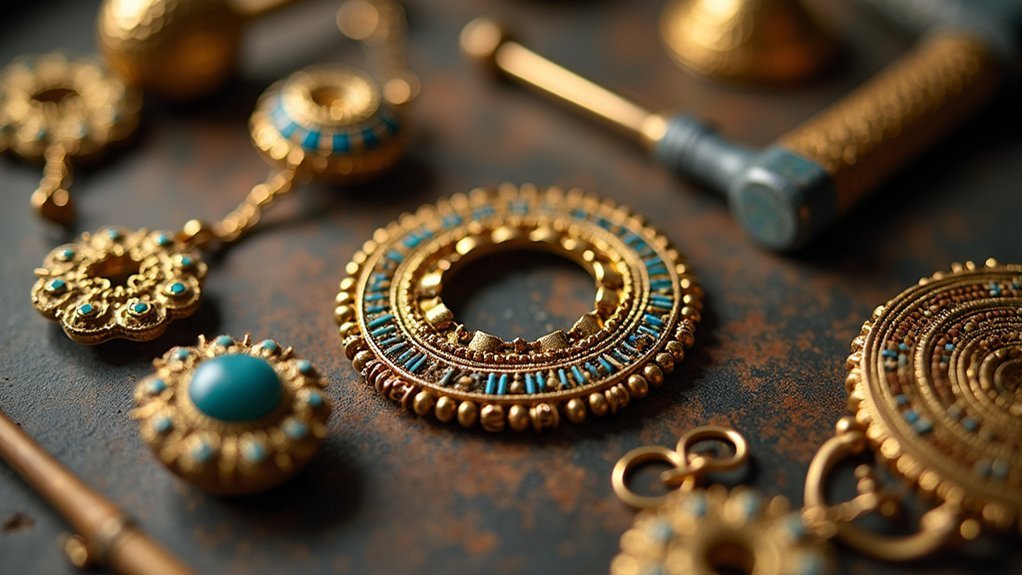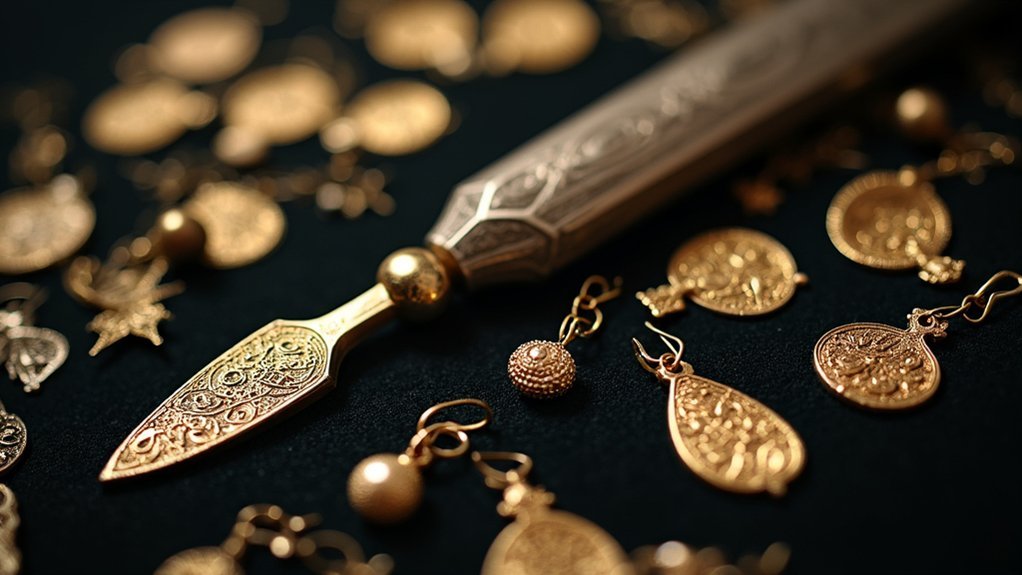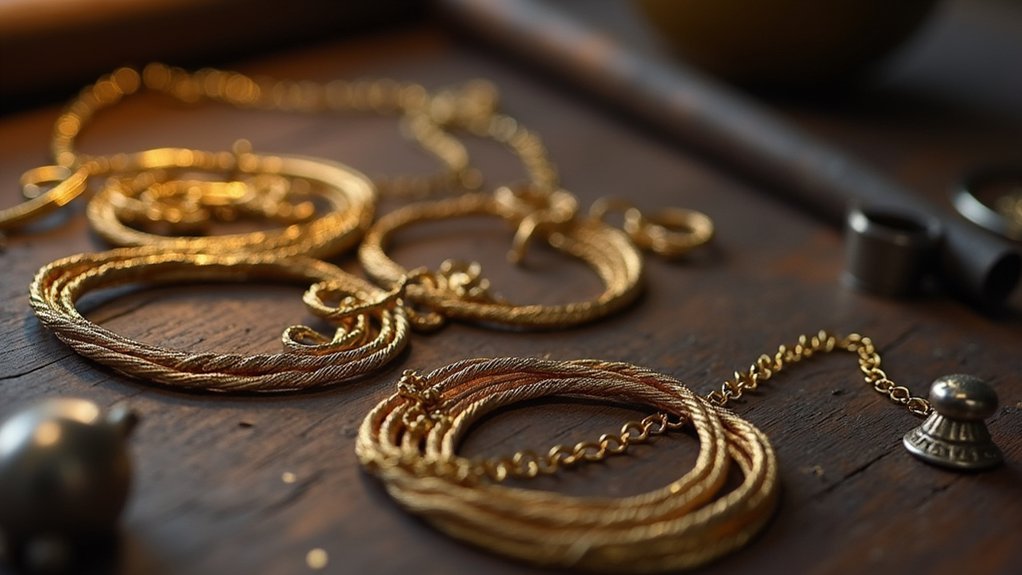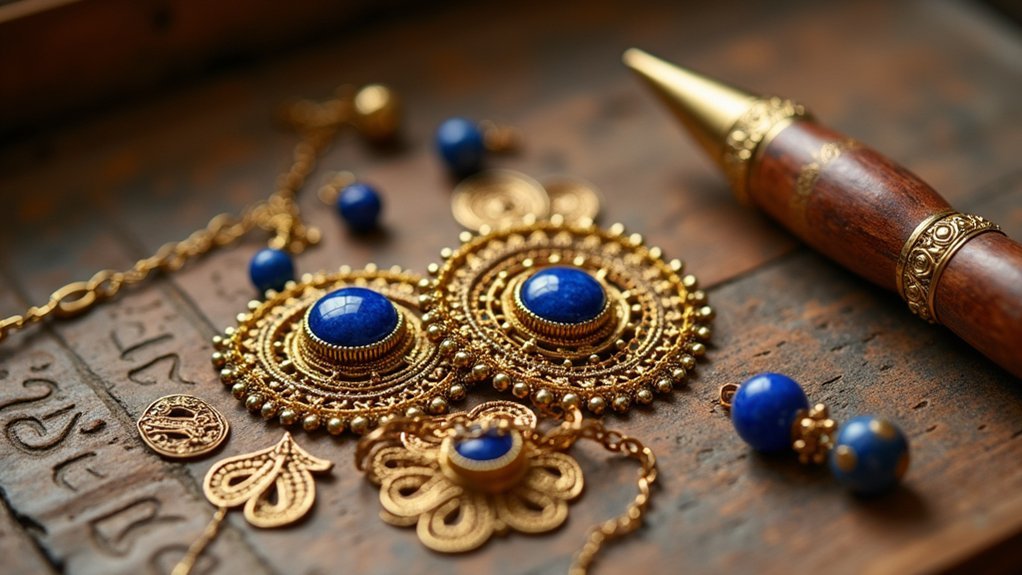You’ll find that traditional Sumerian jewelry creation centered around mastering sophisticated techniques like granulation, where artisans heated tiny metal beads to fuse onto surfaces, and filigree, which involved twisting fine metal threads into intricate patterns. They perfected loop-in-loop chain construction for durability, used specialized hammers and chisels for shaping precious metals, and sourced materials like gold from Turkey, lapis lazuli from Afghanistan, and carnelian from India through extensive trade networks. These ancient methods reveal fascinating details about their remarkable craftsmanship.
Origins and Development of Sumerian Metalworking

While civilizations across the ancient world struggled with basic tool creation, Sumerian artisans revolutionized metalworking around 3500 BCE in Mesopotamia’s mineral-rich river valleys.
You’ll find their innovations centered around abundant mineral deposits along riverbanks, providing essential materials for their craft.
Their development of jewelry reached unprecedented sophistication through techniques like granulation and filigree, enabling intricate designs that showcased remarkable artistic skill.
Sumerian artisans achieved extraordinary jewelry sophistication using granulation and filigree techniques that demonstrated unparalleled artistic mastery and technical innovation.
You’d discover they mastered working with gold and carnelian alongside silver, copper, and electrum, often importing premium materials from Turkey, Iran, and the Indus Valley.
The Sumerians established specialized tools and dedicated workshops that transformed metalworking from basic craft to refined art.
This Sumerian metalworking foundation influenced jewelry-making techniques across future civilizations for millennia.
Materials and Trade Networks in Ancient Mesopotamia
You’ll find that Sumerian jewelry’s exquisite quality depended heavily on materials sourced from distant lands across Southwest Asia.
Your understanding of their craftsmanship isn’t complete without recognizing how gold and silver flowed from regions like Turkey and Iran, while precious gemstones traveled even greater distances.
You can trace lapis lazuli from Afghanistan and carnelian from India, revealing trade networks that stretched thousands of miles to supply Mesopotamian artisans.
Imported Precious Metal Sources
Since precious metals weren’t naturally abundant in Mesopotamia, Sumerian artisans developed extensive trade networks to acquire the gold and silver essential for their elaborate jewelry pieces.
You’ll find that these precious metals were primarily imported from Turkey and Iran, demonstrating the Sumerians’ remarkable ability to establish long-distance commercial relationships.
Their trade networks extended far beyond gold and silver acquisition—they also sourced lapis lazuli from Afghanistan and carnelian from India for their vibrant jewelry designs.
When you examine Sumerian jewelry materials, you’ll notice how these artisans maximized their limited resources.
They created early substitutes for genuine gemstones when trade routes became disrupted, showing incredible innovation.
This sophisticated understanding of material sourcing and aesthetic preferences drove their demand for luxury goods, ultimately strengthening their regional trade connections.
Long-Distance Gemstone Trade
Although gemstones weren’t readily available in the Sumerian heartland, these ancient artisans established remarkable trade networks that stretched across thousands of miles to secure the precious materials their craft demanded.
You’ll find that extensive trade routes, operating before 5000 BC, connected Sumerians to precious stones from distant lands. Lapis lazuli traveled from Afghanistan, while carnelian arrived from India’s markets.
Sumerian goldsmiths and jewelry makers transformed these imported treasures into intricate beads and ornamental pieces. The long-distance gemstone trade was so profitable that commercial jewelry enterprises flourished in major cities like Ur and Babylon.
These sophisticated trading relationships demonstrate how Sumerian jewelry exemplify the civilization’s remarkable ability to source and craft luxury goods from across Southwest Asia and beyond.
Gold and Silver Working Techniques

When you examine Sumerian jewelry from ancient Mesopotamia, you’ll discover that these master craftsmen developed sophisticated gold and silver working techniques that would influence metalworking for millennia.
Sumerian jewelers mastered granulation, fusing tiny gold spheres onto surfaces for stunning decorative effects. They perfected filigree, twisting fine precious metal threads into intricate patterns that showcased their exceptional skill in jewelry making.
These innovative techniques included:
- Granulation mastery – Creating mesmerizing textures that made precious stone inlay sparkle with unprecedented brilliance
- Loop-in-loop chain construction – Fashioning flexible, decorative pieces that moved like liquid gold against the skin
- Electrum alloying – Blending gold and silver to create lustrous, durable metals that captured light magnificently
Using hammers, anvils, and specialized tools, these ancient Mesopotamian artisans achieved remarkable precision in their metalworking craft.
Granulation Methods and Applications
You’ll discover that Sumerian artisans mastered granulation by heating tiny metal beads until they fused onto jewelry surfaces without melting, creating intricate textures around 2750 BCE.
This technique let you achieve stunning decorative patterns that couldn’t be replicated through other metalworking methods of the time.
You can see how they’d combine granulation with filigree work to produce elaborate pieces that showcased their exceptional craftsmanship and artistic vision.
Ancient Granulation Techniques
Since metalworking demanded extraordinary precision, Sumerian artisans developed granulation as one of their most sophisticated jewelry techniques around 2750 BCE.
You’d witness these ancient masters creating intricate designs by fusing tiny metal balls onto base surfaces without soldering. The Sumerians’ exceptional craftsmanship involved heating metal to exact temperatures where surface tension would secure each granule perfectly.
Their granulation techniques produced emotionally engaging pieces:
- Geometric patterns that symbolized divine protection and spiritual connection
- Nature-inspired motifs reflecting their deep reverence for the natural world
- Textures that caught light beautifully, creating mesmerizing visual effects
You’ll find they often combined granulation with filigree methods, enhancing their jewelry’s overall aesthetic appeal.
These metalworking innovations demonstrate how Sumerians transformed simple materials into extraordinary artistic expressions through their advanced granulation techniques.
Decorative Pattern Applications
Although granulation provided the foundation for Sumerian metalwork, the decorative patterns these artisans created through this technique transformed simple jewelry into powerful symbols of identity and belief.
You’ll find that Sumerian jewelry featured geometric shapes, spirals, and nature-inspired motifs meticulously crafted through granulation. These artisans didn’t work with granulation alone—they’d combine it with filigree, twisting fine metal wires into delicate designs that complemented the tiny metal beads.
The decorative patterns you see required advanced skills and expert craftsmanship. Each design demanded precise temperature control to fuse beads without destroying their form.
You’d notice these labor-intensive patterns weren’t just aesthetic choices—they displayed the wearer’s wealth and social status, making each piece a reflection of both artistic mastery and cultural significance.
Filigree Craftsmanship and Wire Working

Delicate metal threads dance through ancient Sumerian jewelry, showcasing the civilization’s mastery of filigree craftsmanship and wire working techniques that transformed simple precious metals into intricate designs works of art.
You’ll discover that Sumerian artisans twisted and curled fine wires into elaborate lacework patterns, creating lightweight yet stunning pieces. Their advanced metallurgical skills enabled them to work with gold, silver, and copper, producing chains and decorative elements that remain impressive today.
The emotional impact of these ancient techniques becomes clear when you consider:
- The painstaking patience required to manipulate each delicate wire by hand
- The artistic vision needed to transform raw metal into spiral motifs and ornate patterns
- The cultural legacy preserved through jewelry that survived millennia
Craftsmen combined filigree with granulation, fusing tiny metal balls onto surfaces to enhance texture and complexity in their Sumerian jewelry masterpieces.
Stone Cutting and Gemstone Setting
You’ll find that Sumerians mastered sophisticated stone-cutting techniques that transformed raw gemstones into polished, brilliant pieces perfect for jewelry creation.
Their expertise with lapis lazuli processing was particularly renowned, as they skillfully shaped this prized blue stone alongside carnelian and agate into intricate designs.
You can see their advanced setting methods involved precise embedding techniques using gold and silver bases, often incorporating the innovative “open fusion” method to create elaborate, nature-inspired motifs.
Ancient Cutting Techniques
When examining Sumerian craftsmanship, you’ll discover that their stone cutting techniques represented a remarkable leap forward in ancient jewelry making.
These advanced methods transformed raw gemstones into polished masterpieces that captured light brilliantly. Sumerian artisans mastered precise drilling and incising techniques, creating intricate patterns that brought their jewelry to life.
Their revolutionary approaches included:
- Carnelian engraving – Detailed designs carved directly into stones for breathtaking seals and decorative pieces
- Open fusion technique – Lightweight yet durable settings that showcased gemstone brilliance like never before
- Precision cutting and fitting – Secure mounting systems for lapis lazuli and carnelian in complex metalwork
You’d be amazed by how these cutting techniques enabled artisans to create settings that perfectly balanced beauty with functionality, establishing foundations for modern jewelry craftsmanship.
Lapis Lazuli Processing
Mastery over lapis lazuli distinguished Sumerian artisans as true gemstone virtuosos. You’ll find their processing methods involved precise stone cutting techniques that transformed raw Afghan stones into polished beads and cabochons. These craftsmen developed sophisticated gemstone setting techniques, seamlessly incorporating the vibrant blue gems into gold objects through advanced filigree work.
| Processing Method | Purpose |
|---|---|
| Stone cutting | Shape raw lapis into beads |
| Polishing | Create smooth surfaces |
| Setting techniques | Integrate into gold/silver |
You’d notice they combined lapis lazuli with carnelian and gold, creating intricate designs with striking color contrasts in necklaces and diadems. Beyond aesthetics, this gem carried spiritual significance, serving as a status symbol that demonstrated wealth and divine connection in Sumerian jewelry collections.
Setting Methods Used
Although raw gemstones possessed natural beauty, Sumerian artisans transformed them into stunning jewelry through sophisticated setting methods that showcased their technical mastery.
You’ll discover that these craftsmen employed three primary techniques to create intricate designs that enhanced each stone’s brilliance.
The setting methods used by Sumerian artisans included:
- Cloisonné – Creating thin metal partitions to securely hold gemstones while maximizing their visual impact
- Filigree – Crafting delicate wire frameworks that elegantly surrounded and highlighted precious stones
- Granulation – Fusing tiny metal beads around gemstones to add remarkable texture and dimensional depth
These advanced techniques allowed artisans to combine metalwork seamlessly with gemstone placement, resulting in jewelry pieces that displayed both structural integrity and breathtaking aesthetic appeal that’s captivated observers for millennia.
Engraving and Cylinder Seal Creation
As Sumerian artisans developed sophisticated metalworking techniques, they simultaneously perfected the intricate art of engraving, transforming both jewelry and administrative tools into canvases for detailed artistic expression.
You’ll find that engraving involved careful carving of designs into materials, creating intricate patterns on jewelry surfaces. Skilled artisans crafted cylinder seals from precious stones like lapis lazuli, incising detailed scenes onto cylindrical surfaces using specialized tools.
When you examine these seals, you’ll notice geometric patterns, animal forms, and religious symbols reflecting Sumerian cultural values. These cylinder seals served dual purposes – they functioned as personal identification marks and enabled authentication of documents and commercial transactions.
The rolling process transferred engraved impressions onto clay, making cylinder seals essential for administrative activities in ancient Sumer.
Welding and Metal Joining Processes

Beyond their mastery of surface decoration, Sumerian artisans revolutionized jewelry creation through sophisticated welding and metal joining processes that allowed them to construct increasingly complex ornamental pieces.
You’ll discover they pioneered soldering techniques, melting filler metals to bond separate components into intricate designs. Their advanced metal joining processes enabled breathtaking craftsmanship in filigree and granulation work.
- Delicate filigree patterns that seem to dance across golden surfaces with thread-like precision
- Tiny granulated spheres meticulously welded into mesmerizing geometric arrangements
- Reinforced joints adorned with decorative elements that transform functional connections into artistic statements
You can appreciate how Sumerian jewelers wielded harder metal tools to manipulate precious gold and silver, creating welded joints that weren’t just durable—they were visually striking masterpieces that showcased their revolutionary approach to metalworking.
Bead Making and Stringing Techniques
The artistry of Sumerian bead creation transformed raw gemstones into vibrant storytelling elements that danced along necklaces and bracelets with deliberate intention.
You’ll discover their bead-making techniques centered on expertly shaping and drilling precious materials like lapis lazuli and carnelian into decorative beads. They’d combine blue, yellow, and red stones to create stunning visual contrasts that caught the eye immediately.
When you examine their work, you’ll notice how beads were strung together using alternating designs that produced intricate patterns throughout each piece.
The loop-in-loop method demonstrated their advanced craftsmanship by seamlessly linking components into flowing chains.
Sumerian artisans enhanced their creations further through delicate filigree techniques, adding sophisticated details that elevated simple beads into extraordinary artistic expressions worthy of royalty.
Loop-in-Loop Chain Construction

Loop-in-loop construction represented one of the most sophisticated metalworking achievements in Sumerian jewelry creation, building upon the foundational techniques used in their bead stringing methods.
This advanced metalworking technique involved creating individual metal loops from precious gold and silver, then linking them together to form flexible and durable jewelry pieces.
You’ll find this loop-in-loop chain construction method produced stunning results:
- Intricate patterns that shimmer with every movement, catching light beautifully
- Flexible chains perfect for necklaces and bracelets that conform to your body
- Durable construction ensuring these treasures lasted for generations
The Sumerian jewelry craftsmen’s expertise in design transformed simple metal loops into sophisticated adornments.
Their innovative craftsmanship created chains that were both functionally superior and aesthetically magnificent, establishing standards that influenced jewelry-making for centuries.
Spiral Motifs and Decorative Patterns
While loop-in-loop chains demonstrated Sumerian technical mastery, spiral motifs revealed their deep artistic vision and connection to the natural world. You’ll find these decorative patterns adorning earrings, bracelets, and pendants, showcasing Sumerian aesthetics through geometric designs that reflected nature’s forms.
| Design Element | Technique | Materials |
|---|---|---|
| Spiral motifs | Granulation | Gold, lapis lazuli |
| Intricate bead arrangements | Filigree techniques | Carnelian, precious metals |
| Geometric patterns | Metal fusion | Bright-colored materials |
| Natural forms | Advanced techniques | Yellow, blue, red stones |
You’d create these stunning pieces using granulation, where craftsmen fused small metal granules together to form complex spiral patterns. The Sumerians’ use of bright-colored materials like lapis lazuli and carnelian enhanced these motifs, while filigree techniques added delicate detail to their intricate bead arrangements.
Tools and Workshop Practices of Sumerian Jewelers
Creating such intricate spiral patterns and complex geometric designs required Sumerian jewelers to master an impressive array of specialized tools and workshop techniques.
You’d find these artisans working with hammers, chisels, and anvils to shape precious metals with remarkable precision. Their workshops weren’t grand establishments—they’d operate from home or communal spaces, creating intimate settings where craftsmanship flourished.
These master jewelers developed sophisticated techniques like granulation and filigree that demanded specialized tools for the most delicate work.
You’d witness them:
- Hand-crafting each bead with meticulous attention to detail
- Stringing colorful lapis lazuli and carnelian using simple threads
- Incorporating advanced metalworking methods that rivaled modern standards
Archaeological discoveries reveal their extraordinary skill level, proving that Sumerian jewelry represented some of history’s finest craftsmanship.
Frequently Asked Questions
How Did Sumerians Make Jewelry?
You’d craft Sumerian jewelry using granulation and filigree techniques with gold, silver, and gemstones. You’d employ loop-in-loop chain methods, alternate colorful beads, and use welding tools for precise, intricate spiral designs.
How Was Ancient Jewelry Made?
You’d craft ancient jewelry using techniques like hammering gold into sheets, wire-drawing for chains, and lost-wax casting. You’d set stones through bezels, apply granulation for texture, and use repoussé to create raised designs on metals.
What Are Three Items That Sumerians Are Believed to Have Invented?
You’ll find that Sumerians invented granulation, which fuses metal granules onto surfaces, filigree involving twisted wire patterns, and cylinder seals that functioned as both personal signatures and decorative jewelry pieces.
What Is Mesopotamian Jewellery?
You’ll find Mesopotamian jewelry represents ancient craftsmanship from 3000 BCE, featuring gold, silver, and precious stones. You’d see intricate earrings, necklaces, and amulets that displayed social status and religious significance across society.
In Summary
You’ve discovered how Sumerian jewelers mastered intricate techniques that’d influence metalworking for millennia. Their granulation methods, filigree craftsmanship, and loop-in-loop construction weren’t just decorative choices—they’re foundations of modern jewelry making. You can see their legacy in today’s workshops, where artisans still use spiral motifs and wire working techniques that Mesopotamian craftsmen perfected over 4,000 years ago. These ancient methods prove that exceptional artistry transcends time.





Leave a Reply